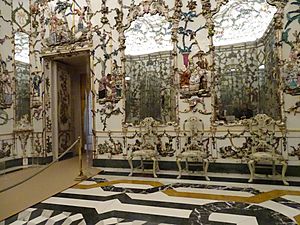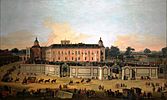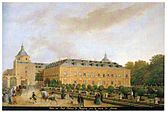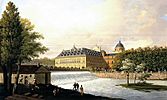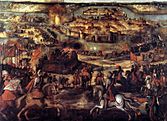Royal Palace of Aranjuez facts for kids
Quick facts for kids Royal Palace of Aranjuez |
|
|---|---|
|
Palacio Real de Aranjuez
|
|
 |
|
| General information | |
| Architectural style | Renaissance |
| Location | Aranjuez (Madrid). Spain |
| Opened | Exclusive property for the monarch: 1523 |
| Management | Patrimonio Nacional |
| Design and construction | |
| Architect |
|
| Type: | Cultural |
| Criteria: | ii, iv |
| Designated: | 2001 (25th session) |
| Part of: | Aranjuez Cultural Landscape |
| Reference #: | 1044 |
| Region: | Europe and North America |
| Official name: Palacio de Aranjuez con sus dependencias | |
| Type: | Non-movable |
| Criteria: | Monument |
| Designated: | 3 June 1931 |
| Reference #: | RI-51-0001063 |
The Royal Palace of Aranjuez (Spanish: Palacio Real de Aranjuez) is a beautiful palace in Aranjuez, Spain. It is one of the official homes of the Spanish royal family. The palace was first built in the 16th century as a royal hunting lodge.
King Philip II ordered its construction. It became one of the four main places where the royal court stayed during different seasons. The palace grounds include amazing gardens and forests with many types of plants.
Important treaties were signed here. Several members of the royal family also passed away at the palace. These included Elisabeth of Valois in 1568 and Barbara of Portugal in 1758.
In 1931, the palace and its grounds were opened to the public. They were declared an important historical monument. From 1977 to 1983, the palace was used to host important guests from other countries.
The palace, its gardens, and other buildings are part of the Aranjuez Cultural Landscape. This area was named a UNESCO World Heritage Site in 2001. Today, the palace has a museum on its ground floor. The royal rooms and gardens are open for everyone to visit. The public agency Patrimonio Nacional manages the palace.
Contents
- A Look at the Palace's History
- Palace Design and Layout
- Plaza de Parejas
- Building Materials
- Palace Entrance
- Inside the Palace
- Queen's Guard Room
- Queen Isabel II's Room
- Musical Antechamber
- Queen's Music Room
- Queen's Ante-Oratory
- Queen's Oratory
- Throne Room
- Queen's Office
- Porcelain Room
- Queen's Bedroom
- Queen's Boudoir
- Ballroom
- Formal Dining Room
- King's Bedroom
- Mirrors' Room
- Moorish Room
- King's Office
- King's Study Room
- Chinese Room
- King's Guard Room
- Palace Paintings
- See also
A Look at the Palace's History
In the 12th century, a group called the Order of Santiago created a special hunting area. It was located near the Tagus and Jarama rivers.
The area became a royal site in the 16th century. The leader of the Order of Santiago, Lorenzo I Suárez de Figueroa, built a large hunting lodge. It was for the order's members and their royal friends. This lodge was known as the Raso de Estrella. Today, this spot is an open park for festivals.
In 1523, Charles I of Spain took control of the area. He named it the Royal Woods and House of Aranjuez. He used it to entertain guests during the spring hunting season.
In 1551, King Charles I started a botanical garden. He wanted to study new plants brought from the Americas. However, he had other things to do, so this project was not fully finished.
Philip II loved the rich lands of Aranjuez. In 1561, he decided that a part of the land north of the Tagus river should be used for farming.
On a nearby plot south of the river, King Philip II began building the first palace. It was on the same spot as the current building. Philip hired architects Juan Bautista de Toledo and later Juan de Herrera. They also worked on the famous El Escorial palace and monastery. The site also had exotic animals like dromedaries (camels). There were about 10 in 1583 and around 40 by 1598.
After Philip's death in 1598, the palace was still not finished. Only the royal apartments, chapel, south tower, and part of the west side were done. Economic problems and the end of the Spanish Hapsburg family led to the project being stopped. Charles of England visited the palace in 1623.
In 1700, Philip V, the first Bourbon king of Spain, decided to continue the work. He wanted Aranjuez to be as grand as the palace of Versailles in France. This grand style was also used for the Royal Palace of La Granja de San Ildefonso. Philip V added a new north tower and finished the west side. This gave the palace its current shape. The royal dromedaries grew to about 200. They were not kept in a zoo but grazed freely or were used for work. The palace was almost destroyed by a fire in 1748.
Ferdinand VI rebuilt the palace. He kept the original foundations but updated the style. The new palace showed the popular late baroque style of the 18th century. It had a grand outside and many richly decorated rooms inside.
The modern palace is largely thanks to Charles III. He was known for improving the capital city, Madrid. The Italian architect Francesco Sabatini designed the two west wings. These wings completed the main building, creating a large courtyard facing the original entrance. At one end was the chapel, and a theater was planned for the other side, but it was never finished.
The palace's decorations were improved in the 18th and 19th centuries. Paintings by various artists were added. The halls received beautiful wooden furniture and collections of tapestries, clocks, lamps, and sculptures. Many unique pieces still decorate the rooms. The Salón de Porcelana (Porcelain Room) was a favorite of Charles III.
Charles III often stayed at Aranjuez to escape politics. He chose it as his spring and summer home. At that time, the royal court would leave Madrid in spring and not return until October.
The King was interested in how land and people create wealth. He enjoyed the palace's rural setting. He created the Cortijo de San Isidro as an experimental farm. He also divided the palace gardens into the private Jardín del Parterre and the larger Jardín de la Isla. He held grand parties and sometimes sailed on the Tagus river in richly decorated boats called falúas.
Charles' son, Charles IV, and his wife Maria Luisa of Parma built a small palace called the Casa del Labrador. This building is open to the public today. It is an important example of Neoclassical architecture.
In 1807, Manuel Godoy, a close advisor to Charles IV, tried to make peace with Napoleonic France. But he faced opposition from the king's son, Ferdinand. In 1808, Godoy was living in Aranjuez. Rumors of a French invasion spread. An angry crowd, led by Ferdinand's supporters, found Godoy hiding. He was captured and later sent away.
Because of this event, called the Mutiny of Aranjuez, King Charles IV gave up his throne. He did this in the palace's Throne Room in March 1808. His son Ferdinand VII became king, but he also gave up the throne in May.
In September 1808, a new government body called the Supreme Central Junta was officially formed. This happened in a ceremony in the Royal Palace of Aranjuez's Chapel.
After the royal family returned to power, Alfonso XII made the Royal Palace of Aranjuez the home for the family of the dukes of Montpensier. His future wife, Mercedes of Orléans, was their daughter. In 1878, she arrived for the wedding ceremony at a temporary train station near the palace.
This was the last major event held at Aranjuez. Later monarchs preferred other palaces for their holidays.
Palace Design and Layout
The palace is the main part of a large royal estate. To the north are former gardens, now farmland. These are crossed by tree-lined "royal rides" that are now walking paths. To the east are three paved roads where noble families built their homes. To the west are matching rural paths, one of which was the royal access road.
Further from the palace is the Raso de Estrella. This was the site of the first hunting lodge and is now a festival ground. The original train station was also here. Directly in front of the palace is an oval lawn with stone benches. To the south is the Plaza de Parejas. This is an open sandy area surrounded by other palace buildings.
Plaza de Parejas
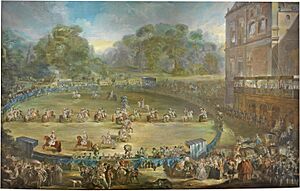
The large open square south of the palace is called Plaza de las Parejas. This name comes from the horse-riding events once held there. In these events, nobles competed or paraded in pairs (parejas).
On the east side of the square is a two-story building in Renaissance style. This was an auxiliary building for the palace. It is now used for local law courts and tax offices. To the west are warehouses and servant halls. After the fire, a separate kitchen house was built there. In front of the palace is the Casa del Principe de Paz, which was meant to be the home of Manuel Godoy.
The palace has two main floors. The ground floor has windows with rounded tops. The upper floor has balconies with iron railings. The central part of the palace rises to a third level. It has a triangular top with the shield of Ferdinand VI. On either side of the shield are inscriptions. The left one says "Philippus II / Institvit / Philippus V / provexit" (started by Philip II and continued by Philip V). The right one says " Ferdinandu / VI Pius Felix / Consummavit / An MDCCLII" (Finished in 1752 by the faithful Ferdinand VI).
Building Materials
The entire palace is built with red brick. It has white limestone details from Colmenar de Oreja.
Palace Entrance
The public usually enters from the east, using the M-305 road. For royalty, the traditional entrance was from the west. They would cross the Tagus river and then travel east. They would enter through the Plaza de Armas and the main entrance of the central building.
The central part of the building is taller to highlight the main entrance. This entrance has five symmetrical arches. On the ledge above are statues by Pedro Martinengo. They show Philip II, Philip V, and Ferdinand VI.
On both sides of the entrance, the wings have three large arches. These also add to the grand look of the royal entrance. Above the entrance is a large balcony with stone railings. It overlooks the courtyard.
The main entrance leads to a hall. This hall then opens to a grand central staircase. Giacomo Bonavía built this staircase for Ferdinand VI. The railing is made of black iron with gold trim, in the Rococo style. A large, gilded bronze and crystal chandelier hangs from the ceiling. It is from La Granja.
Inside the Palace
Behind the palace's main part is an inner courtyard. Various halls are arranged around it. In both corners, you can see two small towers with domes. One of these towers has a clock.
The lobby is decorated with sculptures. On the top floor are three marble busts in alcoves. They show Louis XIV of France, his wife Maria Theresa of Spain, and their son Louis, the Grand Dauphin. These busts were made in 1683 by French sculptor Antoine Coysevox. They are there because of the connections between the Spanish Bourbon family and the French monarchy. The Grand Dauphin was the father of Philip V.
Almost all the halls have clocks of different sizes. King Charles IV was a collector of clocks.
Queen's Guard Room
This room is decorated with three large paintings by Italian artist Luca Giordano. They show scenes from the life of King Solomon. The furniture is made of olive wood from the time of King Charles IV. The clocks are from Charles IV's collection.
Queen Isabel II's Room
This room has paintings by Luca Giordano that show stories from mythology. These include Jupiter and Leda, Aeolus (the god of wind), and Triptolemus. The furniture is in the Empire style.
Musical Antechamber
This room was also called "the tram-station." It was used to welcome important guests. It has biblical scenes painted by 17th-century Italian artists. There are also religious paintings by Francesco Solimena.
Queen's Music Room
An olive wood piano made in England was a gift from Empress Eugénie de Montijo to Queen Isabella II. The other furniture is Empire style mahogany. A bronze neo-Gothic lamp from the 19th century hangs from the ceiling.
Queen's Ante-Oratory
This room has a mosaic made from small pieces of tile. It was created in the Vatican workshop. Pope Leo XIII gave it as a gift to King Alfonso XII when he married Maria Christina of Austria.
Queen's Oratory
The windows of this room look out onto the central courtyard. It was rebuilt during the time of King Charles IV by Juan de Villanueva. The room is decorated with stucco. Its walls have frescoes painted around 1791 by Francisco Bayeu y Subías. He was the brother-in-law of Francisco de Goya. The paintings show scenes like the Adoration of the Magi and the Flight into Egypt. In the center of the ceiling, God the Father is shown with angels. A dove representing the Holy Spirit flies at the top of the dome. The painting of the Immaculate Mary in the center is by Mariano Salvador Maella.
Throne Room
The ceiling of this room has Pompeian style frescoes. They were painted by Vicente Camarón in 1851 and show the idea of Monarchy. The royal crown is held up by figures of Venus and Industry. To the right are Arts, and to the left are Abundance and Prudence. The walls are covered in red velvet. The furniture is mostly from the time of Isabella II. However, the French Louis XVI style royal thrones were used by Alfonso XII and his wife. Kings used this room for formal visits.
Queen's Office
Queen Isabel II used this room as an office. Before that, it was a bedroom. Paintings decorate its walls, including a Vase by Jan Brueghel the Elder. There is also a landscape by Martínez del Mazo. The ceiling has frescoes in Pompeian style by Mariano Salvador Maella. They show scenes from the Passion of Christ. Next to this room is a small private chapel with a painting of the Virgin by Luca Giordano. The lamp hanging from the ceiling is made of glass from La Granja de San Ildefonso. The furniture is from the time of Charles IV. It was made at the Royal Workshop and features beautiful wood inlay.
Porcelain Room
Charles III ordered this room to be built. It was made by the Royal Porcelain Factory of the Buen Retiro in Madrid. This medium-sized room has walls and ceilings completely covered with white porcelain plaques. These plaques have Rococo decorations with chinoiserie designs. These designs include flowers, fruits, monkeys, vases, mandarins, parrots, and dragons. The ceramic plaques are attached to wooden walls with screws. Giuseppe Gricci made them between 1760 and 1765. The floor is marble. Eight large mirrors on the walls make the decorations seem endless. The room also shows groups of people in everyday scenes. In the center of the ceiling, a lamp shaped like a palm tree rises. A Chinese figure with a fan and a monkey on his shoulders climbs the trunk. This room was used for games and play.
Queen's Bedroom
The ceiling has frescoes painted by Zacarías González Velázquez. They show ideas like Science, Virtue, Art, Law, and Monarchy. The main piece is the Isabella II style bed. The city of Barcelona gave it to Queen Isabella II when she married Francis of Assisi of Bourbon. The side tables were made by the French cabinetmaker Daumier's workshop.
Queen's Boudoir
The walls of this room are covered with silk curtains from Valencian factories. The boudoir (dressing table) is made of palo santo wood. It has mirrors on both sides and a chair with mother-of-pearl and gold inlay. The furniture is from the time of Isabella II. The ceiling was painted by Vicente Camarón and shows the four seasons.
Ballroom
This room separates the private rooms of the King and Queen. The furniture is from the late 19th-century Isabella II style. It is not the original furniture, which was lost in a fire in the late 1800s.
Formal Dining Room
This room was once a place for debates during the reign of Ferdinand VI. Charles III used it as a banquet hall for special events. The palace has other, less formal dining rooms. The ceiling is vaulted and was painted around 1750 by Jacopo Amigoni. It has complex symbols. The figure of Father Time is surrounded by women trying to stop time from flying away. Truth is shown as a mother of angels, and Wisdom honors her. The idea of monarchy is shown through its good qualities like Justice, Religion, and Charity. There are also paintings in gray tones that show parts of the world where the monarchy had lands. Sometimes, this room was also used as a ballroom. The floor is in the Rococo style. It has stucco work by Carlo Antonio Bernasconi, showing military items, sheet music, and musical instruments.
King's Bedroom
The Empire style wooden bed is made of mahogany with bronze decorations. The ceiling has frescoes by Jacopo Amigoni and Bartolomé Rusca. They show ideas like Peace, Justice, and Abundance. Above the bed is a painting of Christ on the Cross by Anton Raphael Mengs from 1761. There is also a painting from 1825 of the Madonna and Child by José de Madrazo y Agudo. This room is next to a small hall.
Mirrors' Room
This room is called the Mirrors' Room because its walls are completely covered with mirrors. These mirrors are from the factory at La Granja de San Ildefonso. King Charles IV used this room as a dressing room. The ceiling has frescoes in Pompeian style, painted by Juan de Mata Duque around 1803.
Moorish Room
Queen Isabella II had this room made between 1847 and 1851. It is decorated in a Moorish style, similar to the Sala de Dos Hermanas in the Alhambra in Granada. This room, along with the Porcelain Room, is one of the most admired sights. It has a porcelain central table and a bronze and crystal lamp. It was mainly used as a smoking room for men. The walls are decorated with brightly colored plaster work.
King's Office
This room has a vaulted ceiling with frescoes in Pompeian style by Juan de Mata Duque. They show ideas about the Liberal Arts. There is an olive wood desk decorated with bronze and marble. The Empire style furniture was made by Jacob Desmalter, who was Napoleon Bonaparte's cabinetmaker.
King's Study Room
This room has a Pompeian style vaulted ceiling painted by Juan de Mata Duque. The furniture is in the style of Carlos IV.
Chinese Room
Inside this room is a collection of 203 small paintings. The Emperor of China gave them as a gift to Queen Isabella II. They are made with ink on rice paper. They show scenes from the court, parties, theater, animals, and more. The ceiling has frescoes by Zacarías González Velázquez. They show mythological scenes in the center and countryside scenes on the sides. A globe-shaped lamp with Chinese designs hangs from the ceiling.
King's Guard Room
This is one of the oldest halls in the palace. It was built during the time of Philip II. It has six large paintings by Luca Giordano. Three show biblical themes, and three show military scenes. The mahogany chairs are from the 18th century.
Palace Paintings
-
View of the Royal Palace of Aranjuez by Francesco Battaglioli in 1756. Museo del Prado
-
View of the Royal Palace of Aranjuez from the east side by Fernando Brambila published in the work View of the Royal Sites and of Madrid in 1830
See also
 In Spanish: Palacio Real de Aranjuez para niños
In Spanish: Palacio Real de Aranjuez para niños




